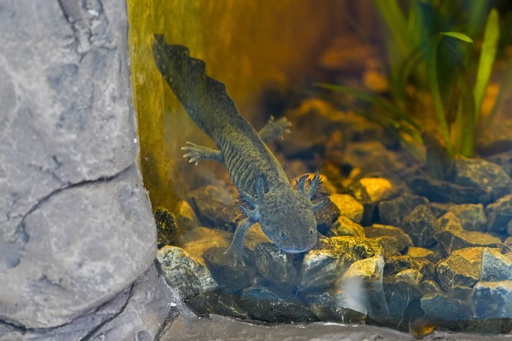MEXICO CITY — According to ancient legends, the axolotl was once a deceitful deity before it transformed into the beloved amphibian known today. This unique creature has become a symbol of pride for many, especially in Mexico, where conservation efforts are underway to prevent its extinction.
Yanet Cruz, director of the Chinampaxóchitl Museum in Mexico City, describes the axolotl as an intriguing animal. The museum’s exhibitions center around both axolotls and chinampas— the ancient floating gardens that are integral to the Xochimilco area, famous for its intricate canals. “Despite the numerous species, the local axolotl is a representation of identity for the indigenous community,” Cruz mentioned, highlighting activities at the museum that commemorate “Axolotl Day” each February.
While formal estimates of the axolotl population are lacking, the species Ambystoma mexicanum, native to central Mexico, has been classified as “critically endangered” on the IUCN Red List since 2019. Despite various efforts from biologists, historians, and authorities to protect both the axolotl and its habitat, an unexpected trend of heightened interest in the species has also surfaced.
Global attention on axolotls surged after their inclusion in the popular game Minecraft in 2021, coupled with the Central Bank’s decision that same year to feature the axolotl on the 50-peso bill. “That’s when the ‘axolotlmania’ began,” Cruz commented. This newfound popularity is evident across Mexico, where the distinctive amphibian has been depicted in murals, crafts, and even clothing. Some bakeries have gained a following for their axolotl-inspired treats, and a local brewery takes its name, “Ajolote,” from this iconic creature to celebrate Mexican heritage.
Historical records suggest that the axolotl may not have received as much attention in pre-Hispanic times as deities like Tláloc, the rain god, or Coyolxauhqui, the moon goddess. However, it is still referenced in ancient Mesoamerican texts. In the Nahua creation myth concerning the Fifth Sun, the god Nanahuatzin entered a fire to become the sun while instructing other gods to do the same to animate the world. All complied, except for Xólotl, who associated with the evening star and ultimately fled. “He was pursued and killed,” explained Arturo Montero, an archaeologist with the National Commission of Protected Natural Areas. “From his demise, the axolotl emerged.”
Montero interprets this myth to mean that after a god’s death, its essence is contained within a common creature, subject to the cycles of existence. Thus, the axolotl embodies Xólotl, meaning that upon its death, the divine essence could transition to the underworld, only to reemerge as a new axolotl. “Axolotl is akin to maize, agave, and water,” Montero said, underscoring its significant cultural ties.
The current intense interest surrounding the axolotl, as well as its sacred significance in ancient times, appears rooted in its remarkable biological traits. Often, the axolotl is difficult to see in tanks used for research and commercial purposes. Their skin, typically dark to blend with stones, can also be bred into an albino variation. They often remain still, either buried in mud or resting at the bottom of their tanks.
The axolotl possesses distinctive features that allow it to thrive in its aquatic setting, including the ability to breathe through gills and skin, alongside its lungs. Remarkably, it can regenerate parts of its heart, spinal cord, and brain. “This species is quite unique,” stated biologist Arturo Vergara, involved in axolotl conservation efforts in several facilities and overseeing specimens in a hatchery based in Mexico City.
Prices for axolotls vary at Ambystomania, where Vergara works, contingent upon their species, color, and size—beginning around 200 pesos (approximately $10). The hatchery sells them once they reach four inches long, and they are considered manageable pets. “They typically live for about 15 years in captivity, but we’ve had some that have reached 20,” Vergara noted. “They are quite long-lived, although they may only survive three to four years in their natural habitat.”
The axolotls presented at the museum are part of one of the 17 known species in Mexico. Found in lakes and canals that are now heavily polluted, a robust population of axolotls would likely face challenges finding food and reproducing. “Just think about the contaminated sediment in areas like Xochimilco, Tlahuac, and Chalco, where there are numerous microbes present,” Vergara explained.
Under ideal conditions, axolotls can heal from predator bites and survive dry seasons by burying themselves in mud—however, sustaining a suitable aquatic environment is essential for such survival. “The efforts dedicated to axolotl conservation are closely linked to the protection of chinampas,” Cruz emphasized, standing next to axolotl-shaped dolls at the museum. “We collaborate with the community to highlight the importance of this environment.”
Chinampas not only provide breeding grounds for axolotls but are also historically significant as irrigation sites for crops like maize, chilies, beans, and zucchini. Yet, even today, some inhabitants continue to cultivate vegetables amidst environmental challenges. “Many chinampas have dried up and are no longer productive,” Cruz noted, adding that remnants of former gardens have been replaced with soccer fields.
For both Cruz and Vergara, the mission of conserving axolotls represents not just the species itself but a larger commitment to preserving the fragile environment that nurtured them. Cruz remarked, “This intricate system of chinampas is one of the last vestiges of the lake city of Mexico-Tenochtitlan. I often remind our visitors that Xochimilco is a living archaeological site. If we don’t take care of what belongs to us, we risk losing it.”




